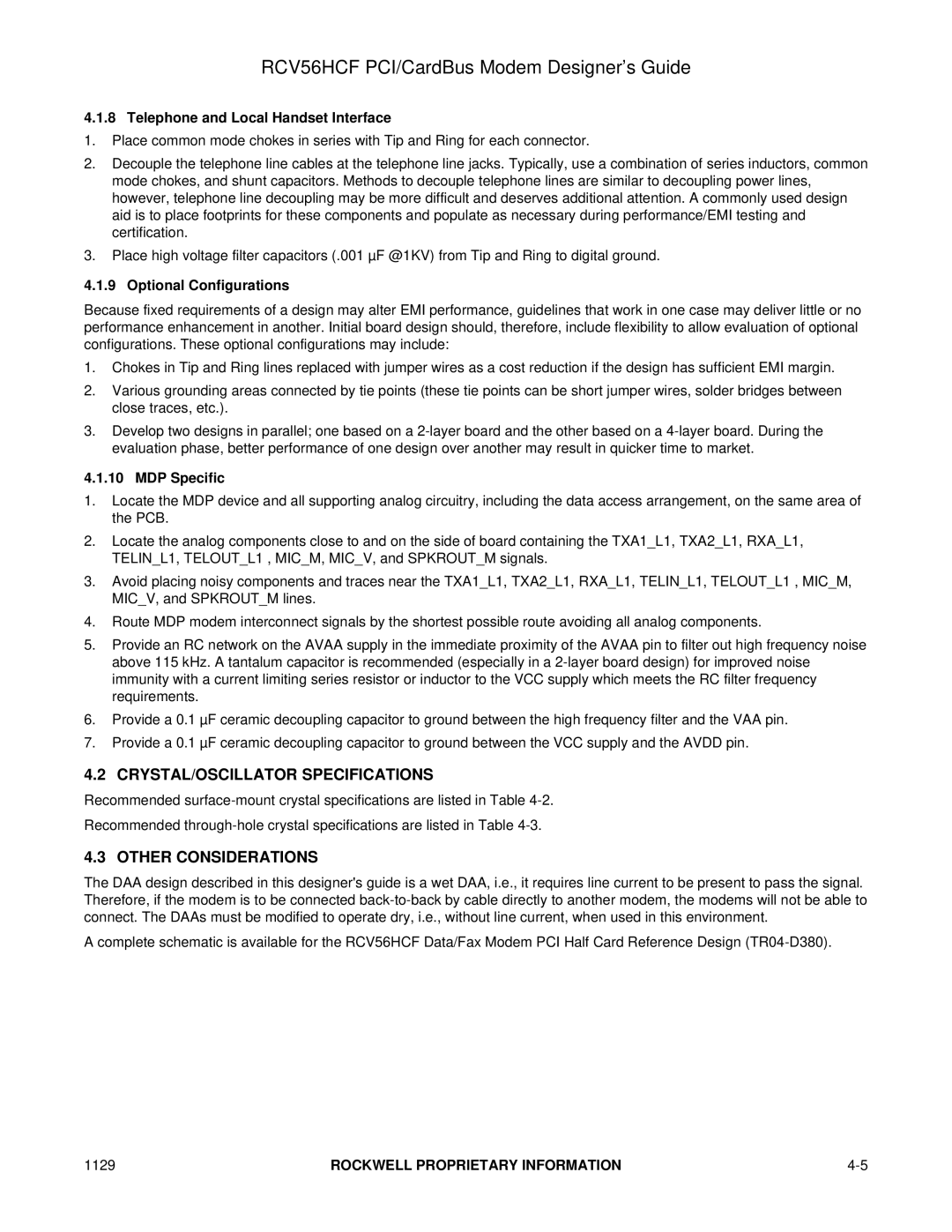RCV56HCF PCI/CardBus Modem Designer’s Guide
4.1.8 Telephone and Local Handset Interface
1.Place common mode chokes in series with Tip and Ring for each connector.
2.Decouple the telephone line cables at the telephone line jacks. Typically, use a combination of series inductors, common mode chokes, and shunt capacitors. Methods to decouple telephone lines are similar to decoupling power lines, however, telephone line decoupling may be more difficult and deserves additional attention. A commonly used design aid is to place footprints for these components and populate as necessary during performance/EMI testing and certification.
3.Place high voltage filter capacitors (.001 µF @1KV) from Tip and Ring to digital ground.
4.1.9 Optional Configurations
Because fixed requirements of a design may alter EMI performance, guidelines that work in one case may deliver little or no performance enhancement in another. Initial board design should, therefore, include flexibility to allow evaluation of optional configurations. These optional configurations may include:
1.Chokes in Tip and Ring lines replaced with jumper wires as a cost reduction if the design has sufficient EMI margin.
2.Various grounding areas connected by tie points (these tie points can be short jumper wires, solder bridges between close traces, etc.).
3.Develop two designs in parallel; one based on a
4.1.10 MDP Specific
1.Locate the MDP device and all supporting analog circuitry, including the data access arrangement, on the same area of the PCB.
2.Locate the analog components close to and on the side of board containing the TXA1_L1, TXA2_L1, RXA_L1, TELIN_L1, TELOUT_L1 , MIC_M, MIC_V, and SPKROUT_M signals.
3.Avoid placing noisy components and traces near the TXA1_L1, TXA2_L1, RXA_L1, TELIN_L1, TELOUT_L1 , MIC_M, MIC_V, and SPKROUT_M lines.
4.Route MDP modem interconnect signals by the shortest possible route avoiding all analog components.
5.Provide an RC network on the AVAA supply in the immediate proximity of the AVAA pin to filter out high frequency noise above 115 kHz. A tantalum capacitor is recommended (especially in a
6.Provide a 0.1 µF ceramic decoupling capacitor to ground between the high frequency filter and the VAA pin.
7.Provide a 0.1 µF ceramic decoupling capacitor to ground between the VCC supply and the AVDD pin.
4.2CRYSTAL/OSCILLATOR SPECIFICATIONS
Recommended
Recommended
4.3 OTHER CONSIDERATIONS
The DAA design described in this designer's guide is a wet DAA, i.e., it requires line current to be present to pass the signal. Therefore, if the modem is to be connected
A complete schematic is available for the RCV56HCF Data/Fax Modem PCI Half Card Reference Design
1129 | ROCKWELL PROPRIETARY INFORMATION |
